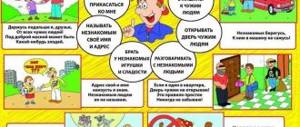The rules of good manners are instilled from childhood. Thanks to them, the child learns to understand how to behave in certain situations. Good manners help people smooth out conflict situations that may arise during children's games. A child is taught rules of behavior in kindergarten, because there he learns to interact with his peers and other adults.
Welcome to kindergarten
You need to start teaching your child good manners even before he goes to preschool. Parents do preparatory work so that the child understands how to behave in a group. They explain to him that in kindergarten he will communicate with different children and he needs to obey the teachers.
Parents say that you need to be polite: you need to say hello, goodbye, thank you. Adults, by their own example, show the child the importance of using polite words not only towards family members, but also towards others. Particular attention is paid to the rules of behavior with other children. The child is taught to share toys, listen carefully, and help.
Parents and teachers need to take into account that during the adaptation period the child may not be up to the rules of behavior. You should treat this with understanding and try to speed up the process as much as possible. Of course, parents and educators are involved in teaching etiquette together.
Rules of conduct for children in kindergarten
The preschool institution hosts festive events, physical education and music classes, during which children move around the territory of the institution. It is very important that the Charter or other regulatory act stipulates the rules of behavior in the kindergarten.
We list the most significant of them:
- Treat preschool employees with respect.
- Move up the stairs, keeping your distance and holding on to the handrails.
- Walk around the facility only on foot and accompanied by adults.
- When moving along the corridors, stick to the right.
- Be in the premises of the institution in replaceable shoes.
Each preschool institution has its own access system to its territory, which should also be reflected in regulatory documents.
When to instill good manners
Some believe that a child should be taught etiquette at the age of 4, when he interacts more with others and attends kindergarten. This is an erroneous statement: the sooner adults explain the rules of behavior to a child, the better he will learn them. Of course, he will begin to understand them at an older age, but he will already have developed the skill of polite communication.
For example, a child already at the age of 1.5 years is taught to say hello and goodbye by waving his hand, and from the age of 2 he is taught table etiquette. In addition to parents, teachers and other kindergarten employees are involved in raising a preschooler. When a child goes to school, his behavior will no longer be so controlled, so the shortcomings in his upbringing will be visible to everyone, and it will be more difficult to eliminate them. Good manners should be instilled at an early age.
Greeting etiquette
The very first thing a child is introduced to is the rules of greeting. They begin to do this even when the baby is just learning to speak, adding a non-verbal gesture - a wave of the hand. This is precisely why the child says “hello!”, “goodbye!” those around him determine whether he knows the basics of politeness. Teachers must discuss the rules of greeting with children in class:
- when meeting family, friends and acquaintances, you need to say “hello!”;
- when greeting, it is best to stop a little and smile, say hello in a friendly tone;
- except “hello!” you can say “good morning!”, “good afternoon!”, “good evening!”;
- When greeting the teacher, you should add his name and patronymic.
Also, when leaving, you must say “goodbye!” And when the parents come for the child, he asks for time off (“Can I go, the teacher’s first and patronymic name”). Polite people always say “Good night” before going to bed. In kindergarten, greeting rules are reinforced through:
- memorizing poems;
- discussions of the behavior of heroes of children's fairy tales and stories;
- staging of role-playing games.
An etiquette teacher explains the importance of greetings. Greeting someone with a smile can lift their mood for the whole day. Greetings are the basics of good manners.
Rules of politeness when talking
Adults should explain to the child that one must always be polite, even during a simple conversation. Polite conversation can help your child make new friends and gain respect from adults. To do this, you need to follow certain rules during a conversation:
- if you are busy with something and someone turns to you, you need to put it aside for a while and answer the question;
- you cannot interrupt - polite people always listen to the end of what the interlocutor says;
- during a conversation, you cannot discuss or call other people names;
- long conversations are tiring, so don’t be overly talkative;
- A polite person always gives his interlocutor the opportunity to talk about something and express his opinion;
- you need to be friendly and attentive;
- Don't gesticulate too much during a conversation.
To strengthen polite communication skills, the teacher plays out various situations with children. In addition to such games, the teacher discusses with the children the behavior of fairy-tale characters, heroes of stories, asks whether they behave correctly, and what a polite person would do. Through conversation, the teacher explains to the children the importance of observing etiquette during conversations, not only in kindergarten, but also at home and away.
Rules of behavior in kindergarten. How to teach children to behave correctly?
In order to set the right tone for the entire preschool education and ensure that all children feel involved in the learning process and are not afraid of anything, it is very important to teach them how to behave correctly. For some children, kindergarten is the first time they are immersed in a group. Therefore, it is important not to demand too much from children and explain all the rules of behavior at the very beginning of the school year.
Create rules of behavior together with the group. Discuss with your children the need and importance of introducing certain rules of behavior in kindergarten. Let the children tell you what they think about the rules of behavior in the group. Together with your children, come up with simple rules of behavior. If children suggest rules like “no biting,” “no kicking,” and “no hitting,” combine them with one general, simple rule: “no fighting.” Once you have established all the rules, you need to discuss with the children what each of them means.
Explain what you want to achieve with each rule. Taking one point of the rules for consideration, role-play situations in which you should do the right thing, in accordance with the rules, and then give an example of how you should not act in this situation. Discuss with your children the circumstances in which you may not strictly follow all the rules and give them the opportunity to ask questions about what they can and cannot do in each specific situation.
Let the children act out each of the agreed rules among themselves. Choose one or two of the preschoolers who will show you how to behave according to the rules. The guys who will illustrate the rule “be a good friend” will have to depict how to take turns playing with toys, without taking them away from each other, without screaming or fighting. Be involved. After the children demonstrate this or that rule, make a comment like: “I liked that Katya said “please” when she asked for a toy.”
Post the created rules in a prominent place in the group and send them to parents for review. Together with your children, figure out how to formalize the rules and allocate a special place for them in the group. It is important that children can periodically look at the rules throughout the day and remind themselves of them. Give the rules booklet to each child and have them explain the rules to their parents. Parents also need to understand why you are doing all this.
Praise children who follow established rules. If you notice that some children behaved correctly in a given situation, praise them individually or in front of the whole group. Come up with special phrases that will remind children to behave correctly. For example: “Sasha is great at following the established rules, not fighting and calmly standing in line.”
Children must be responsible for following established rules. You need to repeat these rules with them every day and set an example for them by doing the right thing in those situations in which the children did something differently than you would like. If you notice non-compliance with the rules of conduct, do not ignore it. Be sure to analyze the situation with the child who broke the rules or with the entire group.
Table manners for children
An important component of etiquette is proper behavior at the table. It should start by explaining to the child that food and the work of cooks must be treated with respect. The most important rule is that they don’t play at the table while eating! But besides this, polite children know and follow the following rules:
- putting your elbows on the table is unsightly;
- do not rock in your chair;
- You can’t talk with your mouth full;
- biting off too large pieces is dangerous;
- soup and porridge are eaten with a spoon, and side dishes and cutlets and fish are eaten with a fork;
- drink drinks in small sips;
- wipe hands and mouth with a napkin.
And after eating, be sure to say “thank you!” and take the dishes with you to the sink. Teachers appoint attendants who help set and clear the table, thereby teaching the child to help adults.
Dining room - Nobility must be cultivated
From the time a baby begins to eat with adults, he needs to be taught table manners. There is no need to teach too complex rules of behavior at the table from an early age: why a certain fork or a certain glass is needed. The child will learn all this later, if necessary. Basic rules of decency are sufficient. The basic rules for child behavior at the table are that you cannot:
- eat by slurping, smacking and chewing with your mouth open;
- do not use a napkin while eating, licking your fingers;
- stuff your mouth too much;
- sit down at the table if the child is not washed, not combed, or dressed unkemptly;
- put your elbows on the table;
- take food with your hands (picking);
- spit out food;
- lean back and rock in a chair;
- sit at the table, lounging.
Need to:
- wash your hands before eating;
- start eating with everyone together;
- eat in silence;
- use napkins;
- give thanks at the end of the meal for the delicious food.
Rules of Friendship
The foundations of friendship are laid in childhood. Adults explain to the child that it is very important to have a friend in life and talk about the special rules of friendship:
- toys need to be shared;
- if something doesn’t work out for a friend, you should help him;
- you need to be able to give in and not quarrel over trifles;
- no need to brag to a friend;
- true friends rejoice in each other's successes and empathize in certain situations;
- friends protect each other;
- you need to be able to accept help and advice from a friend.
The teacher explains to the children that quarrels and misunderstandings can happen between friends. But it is important to be the first to make peace and try to smooth out conflict situations. Examples of friend behavior from children's fairy tales and stories help to learn the rules of friendly behavior.
Rules of conduct in the toilet area and bedroom
Children must behave correctly in the toilet and washing area:
- no more than 6 people can visit the toilet and approach the sinks;
- hands are washed only with soap and dried with a towel;
- after each visit to the toilet you need to flush and use toilet paper;
- You must not splash water, climb onto radiators, or throw various objects into the toilet;
- After each meal, you must rinse your mouth with water prepared by the teacher.
While in the bedroom, children must also adhere to certain rules:
- before “quiet hour” they brush their teeth and visit the toilet;
- they do not take toys with them to bed (with the exception of babies during the adaptation period and the child’s favorite toys);
- clothes are neatly folded on their chair;
- You cannot throw pillows in the bedroom;
- you need to move slowly and calmly.
Compliance with these rules accustoms children not only to etiquette, but also makes them more organized and collected.
Consultation “Rules of behavior in kindergarten”
Olga Agayeva
Consultation “Rules of behavior in kindergarten”
The rules of behavior in kindergarten for children need to be known to all parents and educators, who must convey to preschoolers safe types of interaction in the group. There are several classifications that constitute a certain minimum.
Every parent wants their child to be safe in preschool . However, this will not be possible if children do not understand how to behave correctly in a group . It is for this reason that a list of special rules .
1 Basic rules of behavior for children attending preschool institutions
2 Rules of behavior in the toilet area and bedroom
3 Additional rules for child behavior
Basic rules of behavior for children attending preschool institutions
The first and most important rules are to determine the maximum number of children in the various play areas. Crowds must not be allowed to gather. For example, a maximum of 4 people are allowed in the doll area, and the same rule applies to other play areas.
rules of behavior exist for a child :
It is prohibited to throw toys, balls, cubes and other objects at each other. You should not push and avoid conflict situations if possible. If this does happen, then the teacher plays a decisive role in this case. He is obliged to calm the children and end the conflict.
You cannot bring with you to kindergarten various dangerous objects that can prick or cause cuts. It is advisable not to take your toys from home. Sweets, cookies and medicines are also prohibited.
Board games only involve a specific area. You cannot take small parts or other items from the game box. Before leaving, all parts must be put back in place.
Play by the rules . You must not disturb other participants. You should not crawl under the table or stand on chairs with your feet.
You can use scissors only after the teacher allows it.
Rules of behavior in the toilet area and bedroom.
You cannot enter the washing room without permission.
behavior in the toilet and washing area must comply with the following rules :
Only 6 people at a time are allowed to enter the toilet or approach the sinks.
It is necessary to wash your hands with soap, then dry them with a towel. The toilet must be flushed after each use and toilet paper must be used, and then be sure to wash your hands.
You cannot violate the rules of behavior in the toilet : splash water from the tap, throw foreign objects into the toilet, climb on the radiators.
Bedroom Rules:
Be sure to visit the toilet. You cannot play with any foreign objects in bed.
Clothes must be carefully placed on chairs, which must be in the right place. Avoid throwing pillows and other bedding.
You can't run to the bedroom. You should move calmly, without overtaking the person in front. Do not trip, push or pull on clothing.
When opening and closing the door, be careful not to expose your fingers.
If an injury occurs accidentally, you must inform the teacher about it.
Before going to the first aid station, you need to wash your hands and visit the toilet. You must go only accompanied by a teacher. In the nurse's office, you should not take anything without asking and put it in your mouth. You should behave calmly and not raise your voice. During vaccination, you need to stand still and not twitch. It is not recommended to scream, as this will scare other children. Parents should explain to the child that vaccination is done for good, and there is nothing terrible in the procedure itself.
When conducting music lessons, there must be a teacher with the children who monitors safe behavior . It is prohibited to leave or come on your own. Under no circumstances should you play with musical instruments and disrupt the course of classes. It is not recommended to distract other children and get up from the chair.
Do not touch the piano, play it, or open the lid. During class, it is prohibited to rock on a chair or make loud sounds that are not provided for by the program. While dancing, you should not pull your neighbor or partner’s clothes, try not to step on your feet or push them.
Follow the rules .
Rules of conduct on the playground
Another important organizational point in kindergarten is a walk. Their safety depends on how organized children are. Therefore, the teacher must provide instructions:
- you need to go and return from a walk in pairs and follow each other;
- You cannot leave the playground area or you need to ask the teacher’s permission;
- you can’t run too hard so as not to injure other guys;
- before playing an outdoor game, children must carefully listen to the rules;
- Do not run near swings or carousels.
If children follow these rules and play in an organized manner, the walk will be safe and enjoyable.
Summary of GCD in the senior group “Rules of conduct on the street”
Oleshko Yulia Anatolevna,
higher education teacher cat.,
MBDOU No. 17 “Rucheek”,
Severodvinsk
Summary of direct educational activities in the senior group
"Rules of behavior on the street."
Problem:
“How to avoid dangerous situations on the street”
Game motivation
: Let’s help the kids understand what a “street” is?
Target:
formation of a consciously correct attitude towards compliance with traffic rules as a pedestrian.
Tasks:
1. Reinforce the rules of the road, teach how to apply knowledge previously acquired in practical activities.
2. Activate children’s thinking through:
— developing the ability to define tasks based on the problem posed,
- developing in children the ability to create a conceived product,
— improving the level of accumulated practical skills (creating a street layout, adding details to it).
3. Activate children’s speech through developing the ability to organize their actions and the actions of others.
4. Develop independence and the ability to interact with peers.
Preliminary work:
in kindergarten with teachers - observation of parked cars and traffic while walking; viewing illustrations depicting city streets and different types of transport; work with didactic material “Road Safety”; reading poetry on the topic “Road Rules”; compiling and solving riddles on the topics: “Transport”, “Road signs”; models of buildings (houses, shops, etc.); collective work - compiling the album “Road ABC”;
with parents - monitoring traffic on the street; discussion of various situations (observing how passengers get off and on the bus, where people cross the road, etc.); examining and sketching road signs; selection of material and illustrations for the design of your page in the album “Road Safety”;
creating an environment for organizing and conducting GCD: the baton of the traffic police inspector; circles with a diameter of 10 cm - red, yellow, green; a box containing circles with a diameter of 3 cm of the same colors according to the number of children; blanks: models of buildings - houses, shops, kindergartens, etc., traffic lights, road signs; strips of white paper measuring 5cm by 1cm; three basics for making street layouts (road and sidewalk; intersection; road, sidewalk and stopping place); plasticine, brushes, glue.
Techniques for managing children's activities:
Techniques for setting goals and motivating children’s activities: showing photographs, creating a problem situation, the opportunity to express solutions.
Techniques for activating children’s activities in the process of educational activities: conversation, games, creating a situation aimed at using children’s personal experience, creating a problem situation, analysis and conclusions, physical education.
Parents at a matinee
Parents must also follow the rules of behavior when attending kindergarten. Of course, they must greet and say goodbye to teachers and address them by their first and patronymic names. You also need to ask your child for leave in advance. Particular attention should be paid to the behavior of parents at the matinee:
- they must maintain a festive atmosphere;
- greet the parents of other children and the kids themselves;
- do not brag about your child’s achievements;
- ask all questions to the teacher after the matinee;
- and be sure to thank the teachers for hosting the holiday.
Rules in kindergarten help the child to socialize successfully. They teach him a daily routine, preparing him for school and making him more organized. It is in preschool age that a child is taught to be kind, sympathetic, and treat other people with respect. Parents and daycare staff must work together to raise a polite child.







